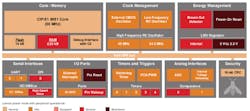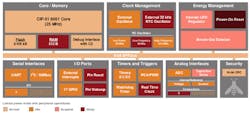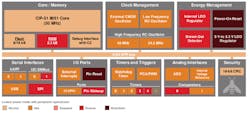Many will tell you that 8-bit microcontrollers are dead. Not so. Silicon Labs' latest 8051-based EFM8 microcontrollers highlights why that is not the case. The EFM8 “Bee” series is divided into three families (Fig. 1). The Busy Bee is the mainstay with a 50 MHz core. The Sleepy Bee is does what it says. It sleeps a lot, consuming only 50 nA in sleep mode. Of course, performance is a tradeoff with a 25 MHz core. Finally there is the Universal Bee with USB support that does not require an external crystal or regulator.
In many ways, 8-bit platforms like the EFM8 are ideal for many Internet-of-Things (IoT) applications as well as conventional embedded applications like motor control and whitebox appliance support. Low-power, low-cost, and easy-to-program solutions make these chips worth considering.
The chips do not have massive amounts of memory, but they are large enough for a wide range of applications. Developers may easily write all the code that would be contained in one of these chip,s although there are plenty of libraries, stacks, and RTOS support options to simplify a developer's job.
The Busy Bee (Fig. 2) targets consumer electronics, sensor, and motor control applications. It has up to 16 Kbytes of flash and 2 Kbytes of RAM. It is available in packages as small as a 3 mm by 3 mm QFN20. It has a pair of 3 Mbit/s UARTs with LIN slave “break and sync” auto-detection support, a 12 Mbit/s SPI, and 3.5 Mbit/s I2C. There are 12-bit, 200 Ksample/s or 10-bit, 800 Ksample/s ADCs. There are two low-current comparators with DAC support. The cross-bar I/O switch allows remapping of pins to provide the best access to peripherals and simplify board layout. It is fully compatible with Silicon Labs' C8051F85x.
The system uses only 150 µA/MHz and it has capacitive touch support. The latter only needs less than 1 µA for wake-on touch support.
The Universal Bee (Fig. 4) incorporates a USB 2.0 interface. The USB support uses an internal oscillator. The low-energy USB takes advantage of bus idle time to reduce power requirements. The USB pins are 8 kV ESD tolerant. The chip support USB BCS V1.2 integrated charger detection.
The Universal Bee has a 48 MHz core to match the USB frequency. It has up to 64 Kbytes of flash and 2.3 Kbytes of RAM. There is a 12-bit, 20-channel ADC on-board. The digital peripheral complement is similar to the Busy Bee.
Starter kits (Fig. 5) are available for $29 that highlight the different feature sets for each family. They include Silicon Labs' built-in advanced energy profiler as well as a flash programmer and debugger. There are EXP expansion cards available to extend functionality. The kits and chips are supported by Silicon Labs' Simplicity Studio.
Pricing for the Busy Bee starts at $0.21 while the Sleepy Bee starts at $0.32. The Universal Bee starts at $0.43.
About the Author
William G. Wong
Senior Content Director - Electronic Design and Microwaves & RF
I am Editor of Electronic Design focusing on embedded, software, and systems. As Senior Content Director, I also manage Microwaves & RF and I work with a great team of editors to provide engineers, programmers, developers and technical managers with interesting and useful articles and videos on a regular basis. Check out our free newsletters to see the latest content.
You can send press releases for new products for possible coverage on the website. I am also interested in receiving contributed articles for publishing on our website. Use our template and send to me along with a signed release form.
Check out my blog, AltEmbedded on Electronic Design, as well as his latest articles on this site that are listed below.
You can visit my social media via these links:
- AltEmbedded on Electronic Design
- Bill Wong on Facebook
- @AltEmbedded on Twitter
- Bill Wong on LinkedIn
I earned a Bachelor of Electrical Engineering at the Georgia Institute of Technology and a Masters in Computer Science from Rutgers University. I still do a bit of programming using everything from C and C++ to Rust and Ada/SPARK. I do a bit of PHP programming for Drupal websites. I have posted a few Drupal modules.
I still get a hand on software and electronic hardware. Some of this can be found on our Kit Close-Up video series. You can also see me on many of our TechXchange Talk videos. I am interested in a range of projects from robotics to artificial intelligence.






